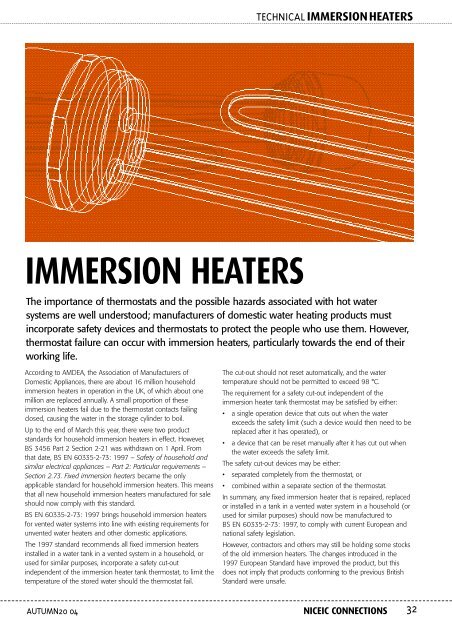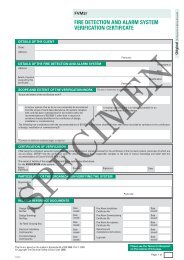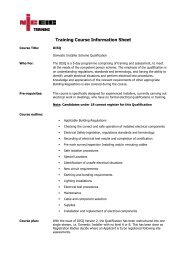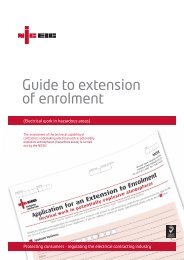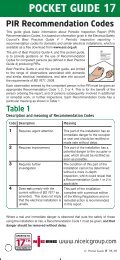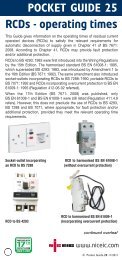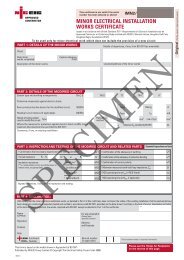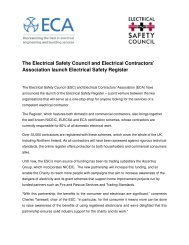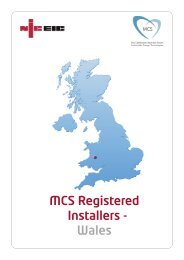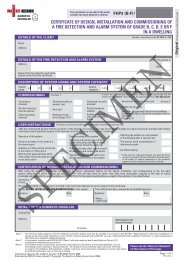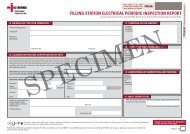PART P - NICEIC
PART P - NICEIC
PART P - NICEIC
You also want an ePaper? Increase the reach of your titles
YUMPU automatically turns print PDFs into web optimized ePapers that Google loves.
TECHNICAL IMMERSIONHEATERS<br />
IMMERSION HEAT E R S<br />
The importance of thermostats and the possible hazards associated with hot water<br />
systems are well understood; manufacturers of domestic water heating products must<br />
incorporate safety devices and thermostats to protect the people who use them. However,<br />
thermostat failure can occur with immersion heaters, particularly towards the end of their<br />
working life.<br />
According to AMDEA, the Association of Manufacturers of<br />
Domestic Appliances, there are about 16 million household<br />
immersion heaters in operation in the UK, of which about one<br />
million are replaced annually. A small proportion of these<br />
immersion heaters fail due to the thermostat contacts failing<br />
closed, causing the water in the storage cylinder to boil.<br />
Up to the end of March this year, there were two product<br />
standards for household immersion heaters in effect. However,<br />
BS 3456 Part 2 Section 2-21 was withdrawn on 1 April. From<br />
that date, BS EN 60335-2-73: 1997 – Safety of household and<br />
similar electrical appliances – Part 2: Particular requirements –<br />
Section 2.73. Fixed immersion heaters became the only<br />
applicable standard for household immersion heaters. This means<br />
that all new household immersion heaters manufactured for sale<br />
should now comply with this standard.<br />
BS EN 60335-2-73: 1997 brings household immersion heaters<br />
for vented water systems into line with existing requirements for<br />
unvented water heaters and other domestic applications.<br />
The 1997 standard recommends all fixed immersion heaters<br />
installed in a water tank in a vented system in a household, or<br />
used for similar purposes, incorporate a safety cut-out<br />
independent of the immersion heater tank thermostat, to limit the<br />
temperature of the stored water should the thermostat fail.<br />
The cut-out should not reset automatically, and the water<br />
temperature should not be permitted to exceed 98 °C.<br />
The requirement for a safety cut-out independent of the<br />
immersion heater tank thermostat may be satisfied by either:<br />
• a single operation device that cuts out when the water<br />
exceeds the safety limit (such a device would then need to be<br />
replaced after it has operated), or<br />
• a device that can be reset manually after it has cut out when<br />
the water exceeds the safety limit.<br />
The safety cut-out devices may be either:<br />
• separated completely from the thermostat, or<br />
• combined within a separate section of the thermostat.<br />
In summary, any fixed immersion heater that is repaired, replaced<br />
or installed in a tank in a vented water system in a household (or<br />
used for similar purposes) should now be manufactured to<br />
BS EN 60335-2-73: 1997, to comply with current European and<br />
national safety legislation.<br />
However, contractors and others may still be holding some stocks<br />
of the old immersion heaters. The changes introduced in the<br />
1997 European Standard have improved the product, but this<br />
does not imply that products conforming to the previous British<br />
Standard were unsafe.<br />
AUTUMN 20 04 <strong>NICEIC</strong> CO N N EC T I O N S 3 2


